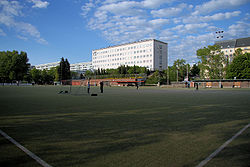
Gunnar Taucher
Encyclopedia

Nordic Classicism
Nordic Classicism was a style of architecture that briefly blossomed in the Nordic countries between 1910 and 1930....
.
Taucher studied architecture at Helsinki University of Technology
Helsinki University of Technology
Aalto University School of Science and Technology , was the temporary name for Helsinki University of Technology during the process of forming the Aalto University...
from 1904 to 1908. Among his first works, designed with colleagues Gösta Kajanus and Rafael Blomstedt during the 1910s, were modest single-family houses designed in the Helsinki suburb of Kulosaari
Kulosaari
Kulosaari is an island and a suburb in Helsinki, Finland. It is also the 42nd neighbourhood of the city. Construction of villas on the island started in the beginning of the 20th century, and a bridge from Sörnäinen was opened in 1919...
. In 1913 Taucher began his career working for the City of Helsinki
Helsinki
Helsinki is the capital and largest city in Finland. It is in the region of Uusimaa, located in southern Finland, on the shore of the Gulf of Finland, an arm of the Baltic Sea. The population of the city of Helsinki is , making it by far the most populous municipality in Finland. Helsinki is...
, reaching the position of City Architect in 1923. Helsinki had been suffering from a severe shortage of affordable housing and Taucher specialised in low-cost housing. He designed the first block of flats for tuberculosis
Tuberculosis
Tuberculosis, MTB, or TB is a common, and in many cases lethal, infectious disease caused by various strains of mycobacteria, usually Mycobacterium tuberculosis. Tuberculosis usually attacks the lungs but can also affect other parts of the body...
sufferers, on Loviisankatu street (1924, extended in 1931). Taucher's most well-known achievement in municipal housing is at Makelankatu street 37-43 (1925-6); the buildings are regarded as one of the best examples of Nordic Classicism. The tripartite, three- and four-storey building of 160 metres long, dominates the centre of the working-class district of Vallila
Vallila
Vallila is a neighbourhood in Helsinki, the capital of Finland.Vallila is a central-northern district, bordered by Pasila to the west and Kallio to the south. Like Kallio, Vallila is mostly residential and has a reputation of a working-class district...
, and is concerned not only with housing provision but also with cityscape.
Taucher also designed several schools and educational buildings in Helsinki. His Workers' Institute (1927), the Käpylä
Käpylä
Käpylä is a neighbourhood of Helsinki with 7,600 inhabitants. Administratively speaking, Käpylä is a part of the Vanhakaupunki district.It is located between Kumpula, Oulunkylä and Koskela...
primary school (1929) and the Aleksis Kivi Primary School (1934) are more pared-down examples of classicism compared to his early works, anticipating the move towards a more purist Modernism
Modernism
Modernism, in its broadest definition, is modern thought, character, or practice. More specifically, the term describes the modernist movement, its set of cultural tendencies and array of associated cultural movements, originally arising from wide-scale and far-reaching changes to Western society...
, shown in one of his later schools, the Lapinlahti school (1939). Other buildings include, the Helsinki Police station on Pieni Roobertinkatu 1-3 (1929) and the Kamppi Electricity company premises (1939), which were later extended in the 1960s by architect Alvar Aalto
Alvar Aalto
Hugo Alvar Henrik Aalto was a Finnish architect and designer. His work includes architecture, furniture, textiles and glassware...
.

